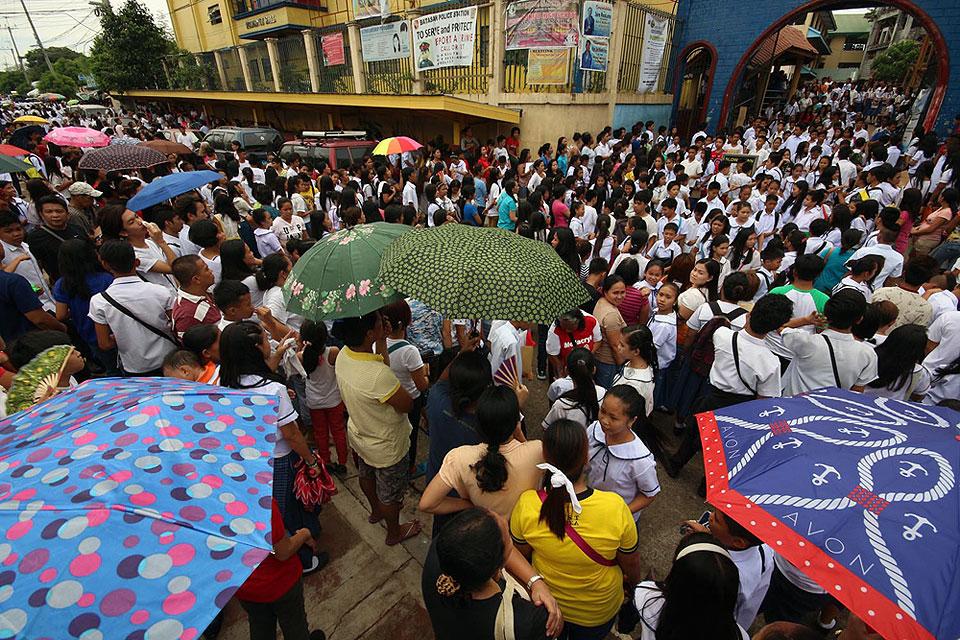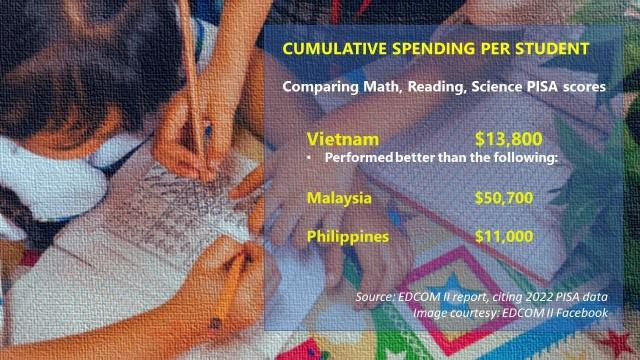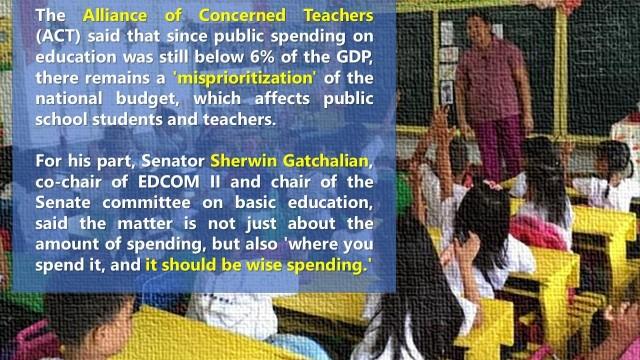The Cost of Miseducation: Lack of investment in PH education sector

The Second Congressional Commission on Education (EDCOM II) acknowledged the long-standing "learning crisis" in the Philippines—a problem that is not only felt first-hand by Filipino students and teachers, but is also dismally evident as shown by national and international assessment results.
With a new academic year about to begin, and a change of leadership unfolding at the Department of Education (DepEd), what needs to be done to address the crisis?
The title of this GMA News Online series is a nod to EDCOM II's year one report, which equates the country's "failed system" of education to one word: Miseducation.
The series takes a close look at prudent spending and management of government resources and education funds, as well as the consequences students and teachers suffer when these responsibilities are not performed well.
This is The Cost of Miseducation.
FIRST OF THREE PARTS
One of the key issues raised in the EDCOM II report released in January 2024 was that the Philippine government, as compared to neighboring countries, has a "historical and persistent underinvestment" in education, resulting in the decline of its quality.
This problem of underinvestment was already raised by the EDCOM I in its 1991 report.
At that time, the commission noted that government expenditure on education was only at 2.7% of the Gross Domestic Product (GDP)—far from the 4.0% minimum recommended benchmark.
More than 30 years later, underinvestment still haunts the country's education sector.
International organizations' suggested public spending on education is at 4% to 6% of the GDP, Senator Sherwin Gatchalian, co-chair of EDCOM II and chairman of the Senate committee on basic education, told GMA News Online in an interview.
Currently, Gatchalian said, the Philippines is still at the lower end of the recommendation, allocating nearly 4% of the GDP to basic education; technical and vocational (TechVoc) education; and higher education, including state universities and colleges (SUCs).
READ: SECOND OF THREE PARTS
The Cost of Miseducation: Handling PH education's purse
READ: LAST OF THREE PARTS
The Cost of Miseducation: Task at hand for PH education
Despite the "substantial growth" in the investments in education since EDCOM I, however, the commission stressed that the Philippines' current amount of investment is still behind compared to other neighbors in the Association of Southeast Asian Nations (ASEAN) like Singapore, Vietnam, and Malaysia—countries that all fared well in the Programme for International Student Assessment (PISA).
The investment gap exists, even though the 1987 Constitution provides that the State shall assign the highest budgetary priority to education.
This year, under the P5.768 trillion 2024 national budget, the education sector remained to be the top priority, according to the Department of Budget and Management (DBM).
The DepEd alone received the lion's share allocation of P717.6 billion under the 2024 General Appropriations Act (GAA).
"DepEd always receives the biggest and the highest allocation, as well as the highest growth in terms of allocation. So not only is it growing big, but it's growing fast. And that's the commitment of the government to education," Gatchalian said.
'Misprioritization'
Despite this, the Alliance of Concerned Teachers (ACT) argued that since the public spending on education was still below 6% of the GDP, there remains to be a "misprioritization" of the national budget, which then affects both public school students and teachers.
"Hindi sumasapat ang budget sa education in a sense na wala pa doon sa 6% of the GDP. So basically kapag may misprioritization o ang tinatawag natin na terminal na usapin ng investment na mababa, may epekto ito sa usapin ng sahod," ACT chairperson Vladimer Quetua said.
(The budget for education is not enough in a sense that it is not even 6% of the GDP. So basically, when there is misprioritization or low investment, this has an impact on the issue of wages.)
Quetua said that teachers usually suffer from being underpaid, overworked, and under-supported regardless of playing a vital role in society and in shaping children's future.
He appealed for the current education budget to be doubled, so that there would be enough funding to provide teachers with sufficient benefits and salaries, as well as to build more classrooms and school facilities, and to pay for additional education support personnel.
When this happens, Queta said, the quality of education in the country will improve.
However, Gatchalian said that it would not be enough to merely increase the education budget.
It is also important to know where to spend the budget, Gatchalian said, and where the spending would be able to yield the most efficient learning outcomes.
"It's not about just the amount of spending. It's also where you spend it, and it should be wise spending," the senator said.
Value for money
Citing data from the 2022 PISA, the EDCOM II report highlighted how Vietnam was able to outperform Malaysia in terms of math, reading, and science despite the latter's higher cumulative spending of $50,700 per student.
Vietnam's cumulative spending per student was at $13,800, which was only slightly higher than the Philippines' $11,000.
Despite the two countries spending approximately almost the same per student, Vietnam was able to score more than 100 points higher than the Philippines in all the three core subjects in PISA.
With this, the EDCOM II indicated that education systems of other countries might have been “more efficient and strategic” in allocating their resources than the Philippines.
“In the case of the Philippines, the stagnant trend in the National Achievement Test scores as well as the dismal performance in the international large-scale assessments despite robust growth in education spending suggest there is room for improvement in how we have managed and allocated our resources thus far,” the report read.

The 2022 PISA results showed that Filipino learners continued to perform badly in math, science, and reading. The Philippines particularly placed third from the bottom in science, and sixth from the bottom in reading and mathematics, among the 81 countries and economies that participated in the study.
DepEd senior education program specialist and PISA focal person Alex Sucalit Jr. had said that the latest PISA results might have shown that the Philippines is about five to six years behind in learning competencies as compared to other countries.
Even outgoing Education Secretary Vice President Sara Duterte had lamented the Philippines’ poor performance on the latest PISA, saying that the results bared an “uncomfortable truth” in the country’s education.
“It has shown that a significant majority of our boys and girls fall below the proficiency level required for full participation in society and contributing to nation-building,” Duterte said in December 2023 when the results came out.
There were a lot of factors to consider as to why Filipino students fell short in international assessments as compared to their foreign neighbors. One major reason for it was the COVID-19 pandemic.
Mathias Cormann, secretary general of the Organisation for Economic Co-operation and Development (OECD) which conducts the PISA studies, had also emphasized that there was a “positive relationship” between investment in education and student performance should there be a cumulative spending of up to $75,000 per student aged 6 to 15.
Then again, the Philippines’ $11,000 cumulative spending per student is still far from this threshold.

Need for more
The government’s low investment in education was also reflected in the governance of Early Childhood Care and Development (ECCD), which is vital for ages 0 to 4.
According to EDCOM II, the lack of financial support for the ECCD programs “hinders equitable access and compromises the quality of services” for young children. The reported insufficiency of resources also affects the compensation for child development workers or teachers, which then impacts the overall quality of ECCD programs.
The DepEd secretary sits as the ex-officio chairperson of the ECCD Council.
EDCOM II also pointed out financial constraints when it comes to implementing Technical and Vocational Education and Training (TVET) under the Technical Education and Skills Development Authority (TESDA).
The commission said that funding should be increased to overcome financial barriers that also hamper access to quality vocational training in the country.
Even in school maintenance and other operating expenses (MOOE), the commission said the current budget levels are also insufficient to fully cover the operating costs of public elementary and high schools.
Based on consultations with school heads and teachers, the commission revealed that 30% to 70% of the school MOOE budget was being spent on utility bills alone, which leaves limited funds for other projects and initiatives that could address local needs and support better learning.
READ: SECOND OF THREE PARTS
The Cost of Miseducation: Handling PH education's purse
READ: LAST OF THREE PARTS
The Cost of Miseducation: Task at hand for PH education
'Never enough'
Given the “underinvestment” in education, how much is needed to alleviate the learning crisis in the country?
DepEd spokesperson Undersecretary Michael Poa said that the DepEd alone is seeking P792 billion under the 2025 National Expenditure Program (NEP).
Poa, however, admitted that this is still inadequate to address the problems in the education sector. Nevertheless, he vowed that the DepEd would work with whatever budget will be given, and maximize it to improve the quality of basic education in the country.
“I think, it's not just with DepEd but common with other national government agencies. It's never enough,” Poa said.
“Siyempre, ‘yung initial proposal natin is mas mataas pa. Marami tayong gustong gawin na projects and programs for education. But, again, we do understand and acknowledge the fiscal restrictions,” he added.
(Of course, our initial proposal was even higher. We want to do a lot of projects and programs for education.)
In 2023, DepEd sought a P758-billion budget under the 2024 NEP. However, even Duterte herself said that the amount was insufficient to cater to all the projects that would improve the country’s basic education.
She said the DepEd initially requested an approximate P900-billion budget for fiscal year 2024, but was only approved around P700 billion under the NEP.
Earlier this month, the Presidential Communications Office (PCO) announced that the President already approved the proposed P6.352-trillion NEP for 2025.
The education sector, composed of DepEd, TESDA, SUCs, and the Commission on Higher Education (CHED), will still be among those that will get the biggest share of the government appropriations next fiscal year. — VDV, GMA Integrated News




